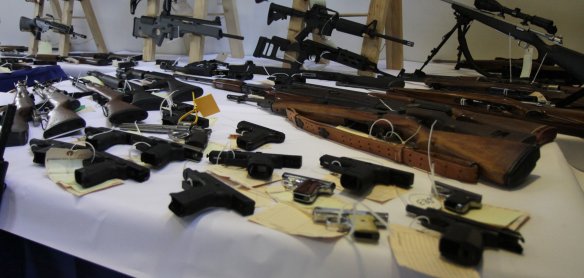The film The Lord of War and high profile trial of Victor Bout helped to seal in the public imagination the image of an illicit arms trafficker as being someone who smuggled planeloads of Kalashnikovs around the world and into war zones.

Example of the firearms seized by the Attorney General of California in a sweep for illegal weapons. Photo: Seth Taylor
Such characters do exist, but the reality of firearms trafficking (especially outside war zones) is very different. With two exceptions, the 48 participating countries did not have wars on their territories, so the study provides a picture of trafficking associated with criminality (and crime accounts for far more deaths than armed conflict). Some of the findings from the study show that firearms trafficking is much more prosaic than often imagined.
A new study published by the UN Office on Drugs and Crime, that has been co-authored by Nicholas Marsh of PRIO, is based upon information reported by 48 countries covering the years 2010-2013 and provides the most extensive available picture of trafficking in firearms, and their parts and ammunition. Previous research has tended to be case studies that provide in-depth information on one location, but not an overview of the wider picture.
Reported firearms trafficking tends to be of handguns, and between neighbouring states
The study examined data reported on firearms that had been seized by police, customs and other law enforcement agencies. Among the 35 countries that reported type of seized firearm, the most commonly reported types seized were handguns (pistols and revolvers), accounting for 53 per cent of all reported seizures. Handguns were the most commonly seized firearm in 21 countries. The largest total quantities of seizures of handguns (over 10,000 per year) were reported in Argentina, Brazil, Colombia, El Salvador, Guatemala and Mexico.
Seizures of machineguns and sub-machineguns were much rarer. Five states did not report any seizures of either type over the four year period covered by the study. Ten states reported fewer than 10 seized machineguns or sub-machineguns per year. The three states that stood out with high levels of seizures were Iraq (1,749 machine guns seized), Saudi Arabia (1,185 sub-machine guns reported seized over a two-year) and Mexico (reported seizures of 1,102 sub-machine guns and 275 machine guns).
In most countries, rudimentary firearms (crude guns made by artisans) were either not reported seized at all, or were fewer than five per cent of all seizures. Nevertheless, they were much more frequently found in the reported seizures of several countries, including Burkina Faso, Ecuador, Ghana, Peru and Trinidad and Tobago.
Instead of guns being flown round the world, the study shows that trafficking reported by the countries participating in the study was mostly local. International trafficking tended to concern neighbouring states, or members of the same region.
Citizens of the state in which the firearms were seized, and citizens of neighbouring countries, were most likely to have been identified by law enforcement as having engaged in firearms trafficking. Trafficking between continents or by nationals from outside the region were rarely reported. Similarly, several countries reported that seized firearms had most commonly been produced in the same country as where the seizure took place (indicating that the firearms had not been smuggled from abroad).
Information provided by states on criminal offences associated with seized firearms suggests that illicit firearms are possessed by people engaged in other forms of criminal activity, primarily trafficking in drugs and other commodities, as well as organized crime and violent crime.
Measuring illicit firearms trafficking
The ‘zero draft’ of the Sustainable Development Goals (set to replace the Millennium Development Goals) contains a commitment to:
16.4 – by 2030 significantly reduce illicit financial and arms flows, strengthen recovery and return of stolen assets, and combat all forms of organized crime
Measuring illicit flows of any form is difficult, but there are a variety of means that can be developed to measure arms trafficking. This new UNODC study is a milestone in the road toward being able to measure illicit firearms trafficking, and so to know whether the goal is being achieved.